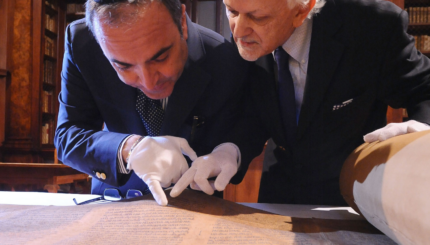Song of Songs is unique in the biblical canon for its sensual nature. In florid poetry, it describes a love that, on a literal level, cannot be anything other than that between a man and a woman. God is never mentioned (Song of Songs is one of just two biblical books with this distinction), nor is there anything explicitly religious in the text itself. There is no moral instruction, no meditations on the nature of faith or exhortations to repentance, no history of the Israelite nation, nor any of the qualities typical of biblical texts. Rather, it plainly describes a man and a woman in erotic pursuit of one another. The text describes the characteristics of their bodies, the sweetness of their smells, the mountains and hills where they conjoin.
But for millennia, Jewish tradition has insisted that the book be read not as love poetry, but as an allegory for the love between the Jewish people and God — a choice long understood as driven by rabbinic discomfort with the text’s unabashed eroticism. Despite God being nowhere to be found in the book, Rabbi Akiva, the great talmudic sage, is famously reported to have said that “while all of the sacred writings are holy, the Song of Songs is the holy of holies.” Less well-known is that Akiva is quoted in the Tosefta (Sanhedrin 12:5) as going even further, saying that whoever reads Song of Songs as erotic poetry has no portion in the World to Come.
Still, the rabbis were on firm ground in seeing the human love described in Song of Songs as an allegory for divine love. Many of the ancient prophets described fidelity to the one God in marital terms. Jeremiah (3:8) describes Israel as having committed adultery against God, who in turn hands down a bill of divorce. Ezekiel (16:1) calls rebellious Jerusalem an “adulterous wife who welcomes strangers instead of her husband.” The Book of Lamentations describes Jerusalem after the destruction of the Temple, God’s earthly abode, as a widow.
Perhaps the oldest example of allegorical interpretation of Song of Songs comes from a mishnah in Ta’anit (4:8), which offers a reading of the verse from Song of Songs 3:11: “O maidens of Zion, go forth and gaze upon King Solomon wearing the crown that his mother gave him on his wedding day, on his day of bliss.” The mishnah explains that the day of Solomon’s wedding refers to the giving of the Torah on Mount Sinai, King Solomon himself (whose name literally means “king of peace”) refers to God, and the day of gladness refers to the future rebuilding of the Temple.
With your help, My Jewish Learning can provide endless opportunities for learning, connection and discovery.
The rabbis of the Talmud performed such feats of exegesis all the time without ever denying that the plain meaning of the text is operative as well. The notion that Song of Songs should only be read allegorically came later. One of the earliest examples of this is the Targum to the Song of Songs, a translation of the biblical Hebrew into Aramaic sometime between 400 and 800 CE. The Targum renders each verse of Song of Songs in a purely allegorical fashion, departing dramatically from the literal text. The third verse of Song of Songs, for example, reads merely: “Your ointments yield a sweet fragrance, Your name is like finest oil, therefore do maidens love you.” In the Targum version of this verse, the original plain meaning is virtually undetectable:
At the sound of your miracle and might which you performed for the people, the House of Israel, all the nations who heard the report of your might and good signs trembled; and your Holy Name was heard in all the earth, and it was more choice than the oil of high office with which the heads of kings and priests were anointed. And therefore the righteous loved to follow the path of your goodness in order that they may possess this world and the world to come.
A more typical rabbinic approach to rendering Song of Songs in allegorical form is found in Shir Hashirim Rabbah, a verse-by-verse exegesis that seeks to demonstrate textually how what seems superficially to be a love poem is really about the relationship between God and Israel. As with other works of rabbinic literature, Shir Hashirim Rabbah is a record of different rabbis teasing out innovative meanings using standard interpretive methodologies, for instance by highlighting similarities in language between different texts. Such similarities are littered throughout Song of Songs, which includes several examples of language used in other scriptural contexts as referring plainly to God and Israel.
In one emblematic passage, an explanation of Song of Songs 2:14 (“My dove, in the clefts of the rocks, hidden by the cliff, let me see your face, let me hear your voice.”), the midrash brings multiple biblical sources to show how various parts of the verse can be read as referring to God and Israel — and in particular, the moment when the Israelites were fleeing Egypt and about to cross through the split sea. According to one teaching, the lover hidden in the cleft of the rock alludes to the fact that the Israelites were for a time hidden in the sea. The request to see the lover’s face hints at Moses enjoining the Israelites at the moment of crossing to “stand and see” God’s deliverance (Exodus 14:13). The desire to hear the lover’s voice refers to the singing that followed the crossing. And the beauty (naaveh) of the lover’s face noted later in the verse alludes to the Israelite declaration (in Exodus 15:2) upon reaching dry land: “This is my God and I will exalt him (v’anveyhoo).”
As many scholars have noted, the literal understanding of the text never entirely disappeared — and at various points was explicitly embraced. The medieval kabbalists in particular took much inspiration from the literal understanding Song of Songs, which was quoted extensively in the Zohar, the most important work of Kabbalah. Jewish mysticism views the union of God and humanity as comparable to the erotic merging of man and woman, which is itself a portal to union with God. Commenting on the second verse of Song of Songs, which describes the longing for a lover’s kiss, the 13th-century kabbalist Ezra of Gerona writes: “The kiss is a parable for the joy attained by the soul in its adhesion to the Source of Life and the endowment of holy spirit.”
In contemporary times, this dichotomy remains in evidence. Liberal Jews often regard the attempt to read Song of Songs allegorically as misplaced, and perhaps even prudish, reflecting a longstanding discomfort among the devout with overt expressions of sexuality. But in the Orthodox world, the allegorical reading of Song of Songs remains the dominant one. In the spirit of the Targum, the version of Song of Songs published by Artscroll, a leading Orthodox publishing house, offers only an allegorical translation, and echoing Rabbi Akiva insists in the introduction that the literal meaning of the text is “false.” The famous second verse, which asks the lover for the kisses of her mouth, is rendered thus in the Artscroll edition: “Communicate your innermost wisdom to me again in loving closeness.”



